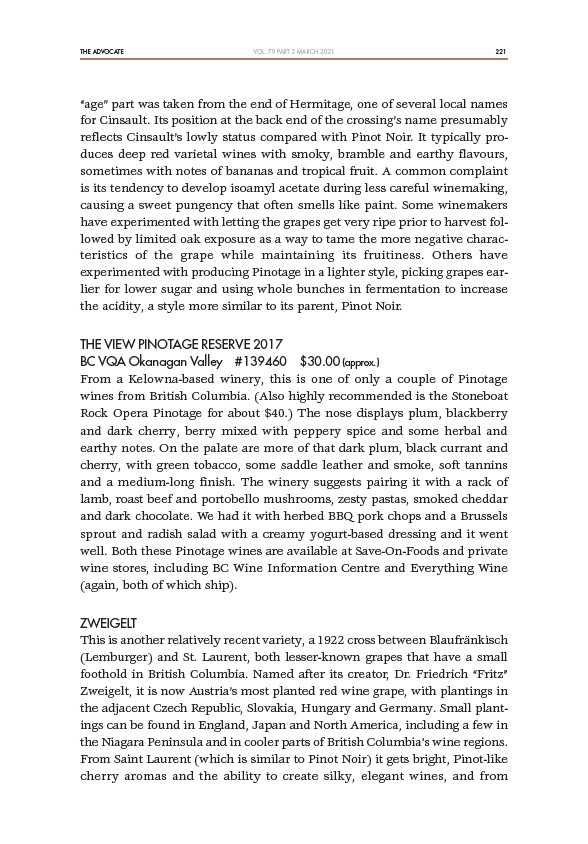
THE ADVOCATE 221
VOL. 79 PART 2 MARCH 2021
“age” part was taken from the end of Hermitage, one of several local names
for Cinsault. Its position at the back end of the crossing’s name presumably
reflects Cinsault’s lowly status compared with Pinot Noir. It typically produces
deep red varietal wines with smoky, bramble and earthy flavours,
sometimes with notes of bananas and tropical fruit. A common complaint
is its tendency to develop isoamyl acetate during less careful winemaking,
causing a sweet pungency that often smells like paint. Some winemakers
have experimented with letting the grapes get very ripe prior to harvest followed
by limited oak exposure as a way to tame the more negative characteristics
of the grape while maintaining its fruitiness. Others have
experimented with producing Pinotage in a lighter style, picking grapes earlier
for lower sugar and using whole bunches in fermentation to increase
the acidity, a style more similar to its parent, Pinot Noir.
THE VIEW PINOTAGE RESERVE 2017
BC VQA Okanagan Valley #139460 $30.00 (approx.)
From a Kelowna-based winery, this is one of only a couple of Pinotage
wines from British Columbia. (Also highly recommended is the Stoneboat
Rock Opera Pinotage for about $40.) The nose displays plum, blackberry
and dark cherry, berry mixed with peppery spice and some herbal and
earthy notes. On the palate are more of that dark plum, black currant and
cherry, with green tobacco, some saddle leather and smoke, soft tannins
and a medium-long finish. The winery suggests pairing it with a rack of
lamb, roast beef and portobello mushrooms, zesty pastas, smoked cheddar
and dark chocolate. We had it with herbed BBQ pork chops and a Brussels
sprout and radish salad with a creamy yogurt-based dressing and it went
well. Both these Pinotage wines are available at Save-On-Foods and private
wine stores, including BC Wine Information Centre and Everything Wine
(again, both of which ship).
ZWEIGELT
This is another relatively recent variety, a 1922 cross between Blaufränkisch
(Lemburger) and St. Laurent, both lesser-known grapes that have a small
foothold in British Columbia. Named after its creator, Dr. Friedrich “Fritz”
Zweigelt, it is now Austria’s most planted red wine grape, with plantings in
the adjacent Czech Republic, Slovakia, Hungary and Germany. Small plantings
can be found in England, Japan and North America, including a few in
the Niagara Peninsula and in cooler parts of British Columbia’s wine regions.
From Saint Laurent (which is similar to Pinot Noir) it gets bright, Pinot-like
cherry aromas and the ability to create silky, elegant wines, and from